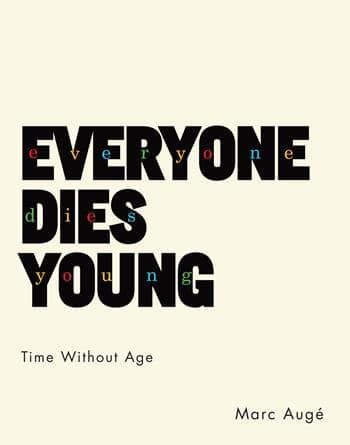I have carried Marc Augé’s book Everyone Dies Young (New York: Columbia University Press 2016), with me everywhere these past two months. When walking through a meadow or crammed on a bus, I’ll open the book to a random page, read a paragraph, close it, and have enough intellectual fodder from his few, yet loaded lines to tinker newly with concepts like age, death, the self, and time. This is significant: a doctoral student studying old age, I am awash constantly with scholars’ ideas on the complexity of human finitude. When not at the desk I tend to wander away from thinking about mortality for sanity’s sake, but this book has been hard to put down. Plainly, Augé’s thinking on old age has made me more playful with my own. To incite such creativity in the realm of aging and death is no small feat; it feels, in fact, distinctly victorious.
 Augé’s work inspires not simply because his brief account offers a sprawling experience and depth of intimacy that rich novels, for example King Lear and Remains of the Day, achieve. It is also that Augé’s work, in which he has made the personal anthropological, reels you into an analyzed life-world with a powerful theoretical point. If you are moved to read old age as a chokehold, Augé tempts you otherwise. Offering himself as informant, he exhibits agency amidst the social constructs of age, taking human contingency, our being in time, as the foundation of our freedom. And by offering ethnographic examples, Augé has sharpened my eyes to see the multitude of agentive possibilities in old age, where age itself is the constrictor.
Augé’s work inspires not simply because his brief account offers a sprawling experience and depth of intimacy that rich novels, for example King Lear and Remains of the Day, achieve. It is also that Augé’s work, in which he has made the personal anthropological, reels you into an analyzed life-world with a powerful theoretical point. If you are moved to read old age as a chokehold, Augé tempts you otherwise. Offering himself as informant, he exhibits agency amidst the social constructs of age, taking human contingency, our being in time, as the foundation of our freedom. And by offering ethnographic examples, Augé has sharpened my eyes to see the multitude of agentive possibilities in old age, where age itself is the constrictor.
Augé helpfully differentiates the concept of age and time. The construct of age is ‘the detailed account of the days that pass,’ the linear and inevitable march between a date of birth and death. On the other hand, time, the ‘raw material of our imagination’, is something we ‘project ourselves into’, ‘play with’ and ‘reinvent’ (4). As beings in time, we can pause, change rhythm, interpret the past differently and be unsure of the future. The passing of time does not simply unfold fate, rather it presents us with the opportunity to change. And while time offers us freedom, Augé importantly shows the ways in which age, the normative Western way to tell time, has permeated into the category of time itself. With meticulous description, Augé reveals how we may abide by age’s logic in our thinking, how we feel its confining force on our subjectivities, and how we might mistake our being in time as bound to age’s order. Yet time still slips from age’s grasp: Augé therefore fine-tunes time into an analytical weapon of the old.
The eleven brief chapters included in this work serve at once as narrow and expansive meditations on a range of themes relating to age and time. Perhaps most powerfully, Augé challenges the notion that old age delivers a common bodily state. Drawing on insights from Cicero and Rousseau to de Beauvoir and Leiris. Augé makes the essential point that old age does not corner or alone beget feebleness or bad health; indeed, the unequal distribution of frailty internationally forces us to consider why vulnerability is read as biological fate and not a social fact.
What then constitutes the content of old age as category, stripped of its inevitable biological side effects?
Augé explores this existentially and socially, situating himself through different lenses to discern construction: ‘Who am I, who was I?,’ he asks. ‘Who goes there, who lives? Who is there? Who will come? What am I – an illusion, a memory, an absence, a desire?’ (27). Though mortality is a necessary fact of embodiment, the question is: what exactly has that come to mean in context? ‘We “have” our age’, Augé writes, ‘but it also has us’ (73). And the recognition of such a hermeneutic allows Augé to correct the notion that old age ushers in unavoidable decay, quoting a common phrase: ‘“Five minutes before his death, Monsieur de La Palisse was still alive.” Yes,’ Augé underscores, ‘exactly.’ (74).

Augé’s first person account delivers reflections on his own experience of age not from the social to the particular, but from the particular to the social. In this, Augé gives us his own construction of selfhood and the meta-analysis of it (‘If I say to myself, a little disillusioned, “Oh well, my old man, you’re not getting any younger…,” I recognize myself without identifying with myself’) and lets us in to what he calls ‘the divided consciousness’ (34). Augé displays how he notices, acts on, reflects and then reforms his ideas. His situated-ness is robust and spans across several realms – for example, the effect of belonging to a military school class, or his own participation in one generation relative to others – and it reveals the worth in charting a person’s experience with their being over time. His chapter on nostalgia only further adds to his argument that persons are like ‘palimpsests’, whose histories and learned behaviors interject curiously through memory and practice.
Never finished projects, social persons emerge unexpectedly.
In this work, Augé offers theories about his own aging experience and then tests them, recalls memories and then challenges his own interpretation. In this he writes himself without a clear narrative arc, presenting the reader with the option to discern which explanation best captures the rich examples offered.
To be free of age, ‘one only has to achieve it,’ Augé suggests. And according to him, it is the realization of time’s contingency, the sense that at any moment possibility lies before us, that we learn how to see ourselves not as people doomed to the inevitable linear trajectory of age, but as people who can define how they are going to be in time. While Augé thinks freedom requires conscious decision-making, what he identifies as the ‘free-floating attention that eludes fate, accident, and age,’ one wonders if simply being ‘out of’ the linearity of age’s time and within an alternative time might allow for the kind of free-floating possibility that Augé seems to desire. I think here of the men and women with dementia in the retirement community in which I did my fieldwork. It would be difficult to classify their different temporalities as agency under the consciousness rubric, and yet their alternative temporality provoked and bent the power of order and control by which the home abided. It was unclear whether the residents with dementia were intending to resist and to provoke, but their actions and behaviors accomplished just that. Though locked under the confining conditions of age, their time was defiant.
Is the Western concept of age, like our bodies, prone to crumble under time’s upending force?
Augé generally provokes a question about social change and time: do we consciously need to create time’s openness, or is time’s inherent contingency itself always already girded with the possibility of freedom? But it also leads to another, perhaps more radical, question: if we privilege time and temporality as the theoretical starting point, how might that change the very way we think through what it means to be, and to become free? Most powerfully, Augé’s account shows that age, the linear passing of time, is not the only way we live in time nor the only lens through which we, as anthropologists, should think about living in time; indeed, age is but one way to think about our experience of living in time. Though Western clocks often abide by the logic of age, Augé shows us that even he, a Western person, has lived in time with a much less straightforward trajectory. Living in time for Augé is not merely the consideration of the past, present or future, nor simply the entwinement of all three in one consideration, but it is also the insight into how projects of temporality are embodied, individualized, and socialized. Augé collects several experiences of age together in his book, exploring embodiment, selfhood, memory, and writing, and it is the totality of his work, taken together, which engenders the sense that we may benefit analytically from putting age aside and placing time at the center.
Featured image by Mon Œil (flickr, CC BY 2.0)





